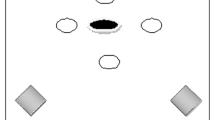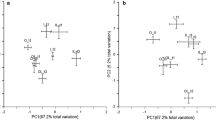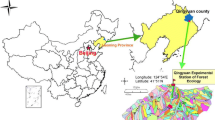Abstract
Key Message
Tree influence on litter and soil features is detectable even in a mixed stand and the soil landscape may be considered as a mosaic of profiles reflecting the occurrence and chemical characteristics of the various tree species present.
Abstract
The forest soils can be strongly influenced by tree species. Many studies have addressed the effects of monocultures on soil features, but few have examined the effects of individual trees within a mixed stand. This work illustrates the differences of litter and soil characteristics in a coastal mixed forest stand in northern Iran. For this purpose, the Alnus glutinosa (AG), Populus caspica (PC), Ulmus minor (UM) and Parrotia persica (PP) species were examined; litter and soil samples were taken under tree canopy cover. Litter quality differed among the tree species, with the highest total N concentration (1.83%) and lowest organic C (38.38%) under AG species. Soil pH (7.19), EC (0.29 ds/m), total N (0.33%), available P (26.21 mg kg−1), available Ca (257.30 mg kg−1), available Mg (56.80 mg kg−1), earthworm density/biomass (4.00 n m−2 and 49.47 mg m−2, respectively), microbial respiration (0.49 mg CO2–C g −1soil day−1), net soil ammonification (0.44 mg kg−1 day−1) and N mineralization rate (0.30 mg kg−1 day−1) were significantly higher under AG canopy whereas a higher content of available K (355.80 mg kg−1) and fine root biomass (95.02 g m−2) were found under the PC and UM tree species, respectively. Soil organic carbon and net soil nitrification were not significantly different among tree species. The results of this case study demonstrate that tree influence on litter and soil features is detectable even in a mixed stand and the soil landscape of such forests may be considered as a small-scale mosaic of profiles reflecting the occurrence and chemical characteristics of the various tree species present.


Similar content being viewed by others
References
Akbarian Kelaki MR (2010) The investigation of ecological and plant biodiversity of Parrotia persica stands in Eastern Hyrcanian forests. M.Sc. thesis of Forestry, Tarbiat Modares University, p 95
Alef K (1995) Soil respiration. In: Alef K, Nanninipieri P (eds) Methods in applied soil microbiology and biochemistry. Academic Press, London, pp 214–219
Aosaar J, Varik M, Lohmus K, Ostonen I, Becker H, Uri V (2013) Long-term study of above- and below-ground biomass production in relation to nitrogen and carbon accumulation dynamics in a grey alder (Alnus incana (L.) Moench) plantation on former agricultural land. Eur J For Res 132:737–749
Aponte C, García LV, Marañón T (2013) Tree species effects on nutrient cycling and soil biota: a feedback mechanism favoring species coexistence. For Ecol Manage 309:36–46
Asadiyan M, Hojjati SM, Pourmajidian MR, Fallah A (2013) Impact of land-use management on nitrogen transformation in a mountain forest ecosystem in the north of Iran. J For Res 24:115–119
Augusto L, Ranger J, Binkley D, Rothe A (2002) Impact of several common tree species of European temperature forests on soil fertility. Ann For Sci 59:233–253
Bardgett RD, Wardle DA (2010) Aboveground-belowground Linkages. Biotic interactions, ecosystem processes and global change. Oxford University Press, Oxford
Binkley D, Hart SC (1989) The components of nitrogen availability assessments in forest soils. Adv Soil Sci 10:57–112
Booth MS, Stark JM, Rastetter E (2005) Controls on nitrogen cycling in terrestrial ecosystems: a synthetic analysis of literature data. Ecol Monogr 75:139–157
Bower CA, Reitemeier RF, Fireman M (1952) Exchangeable cation analysis of saline and alkali soils. Soil Sci 73:251–261
Bremner JM, Mulvaney CS (1982) Nitrogen-total. In: Page AL, Miller RH, Keeney RR (eds) Methods of soil analysis, part 2, 2nd edn. American Society of Agronomy, Madison, pp 595–624
Cao YS, Lin YB, Rao XQ, Fu SL (2011) Effects of artificial nitrogen and phosphorus depositions on soil respiration in two plantations in southern China. J Trop For Sci 23:110–116
Chandrashekara UM, Mujeeb Rahman P, Baiju EC (2010) Soil health analysis using earthworms as the indicator—possibilities and constraints. Kerala Forest research Institute Sub Centre, Nilambur
Chase P, Singh OP (2014) Soil nutrients and fertility in three traditional land use systems of Khonoma. Resour Environ 4:181–189
Chen D, Wang Y, Lan Z, Li J, Xing W, Hu S, Bai Y (2015) Biotic community shifts explain the contrasting responses of microbial and root respiration to experimental soil acidification. Soil Biol Biochem 90:139–147
Chodak M, Niklinska M (2010) Effect of different tree species on the chemical and microbial properties of reclaimed mine soils. Biol Fertil Soils 46:555–566
Cookson WR, Osmar M, Marschner P, Abaye DA, Clark I, Murphy DV, Stockdale EA, Watson CA (2006) Controls on soil nitrogen cycling and microbial community composition across land use and incubation temperature. Soil Biol Biochem 39:744–756
Duran J, Rodriguez A, Palacios JMF, Gallardo A (2009) Changes in net N mineralization rates and soil N and P pools in pine forest wildfire chronosequence. Biol Fertil Soils 45:781–788
Eichhorn J, Huttermann A (1994) Humus disintegration and nitrogen mineralization. In: Godbold DL, Huttermann A (eds) Effects of acid rain on forest processes. Wiley, New York, p 129
Eno CF (1960) Nitrate production in the field by incubating the soil in polyethylene bags. Soil Sci Soc Am J 24:277–279
Esmaeilzadeh O, Hosseini SM, Asadi H, Ahmadi A (2010) Study on Lymantria dispar in plain forests of Noor. Iran J Natl Ecosyst 1:47–62
Esmaeilzadeh O, Hosseini SM, Asadi H (2012) Conservation project of plain forests of Tarbiat Modares University. TMU publication, Delhi, p 245
Eviner VT, Chapin FS (2003) Functional matrix: a conceptual framework for predicting multiple plant effects on ecosystem processes. Annu Rev Ecol Evol Syst 34:455–485
Fanin N, Bertrand I (2016) Aboveground litter quality is a better predictor than belowground microbial communities when estimating carbon mineralization along a land-use gradient. Soil Biol Biochem 94:48–60
Garbeva P, Postma J, Van Veen JA, Van Elsas JD (2006) Effect of aboveground plant species on soil microbial community structure and its impact on suppression of Rhizoctonia solani AG3. Environ Microbiol 8:233–246
Gnankambary Z, Ilstedt U, Nyberg G, Hien V, Malmer A (2008) Nitrogen and phosphorus limitation of soil microbial respiration in two tropical agroforestry parklands in the south-Sudanese zone of Burkina Faso:the effects of tree canopy and fertilization. Soil Biol Biochem 40:350–359
Gregory PJ (2006) Roots, rhizosphere and soil: the route to a better understanding of soil science? Eur J Soil Sci 57:2–12
Gruselle MC, Bauhus J (2010) Assessment of the species composition of forest floor horizons in mixed spruce-beech stands by Near Infrared Reflectance Spectroscopy (NIRS). Soil Biol Biochem 42:1347–1354
Haghdoost N, Akbarinia M, Hosseini SM, Kooch Y (2011) Conversion of Hyrcanian degraded forests to plantations: effects on soil C and N stocks. Ann Biol Res 2:385–399
Haque SS, Gupta SD, Miah S (2014) Deforestation effects on biological and other important soil properties in an upland watershed of Bangladesh. J For Res 25:877–885
Homer CD, Pratt PF (1961) Methods of analysis for soils, plants and waters. University of California, Agricultural Sciences Publications, Berkeley, p 309
Hoogmoed M, Cunningham SC, Baker PJ, Beringer J, Cavagnaro TR (2014) Is there more soil carbon under nitrogen-fixing trees than under non-nitrogen-fixing trees in mixed-species restoration plantings? Agric Ecosyst Environ 188:80–84
Huang X, Liu S, Wang H, Hu Z, Li Z, You Y (2014) Changes of soil microbial biomass carbon and community composition through mixing nitrogen-fixing species with Eucalyptus urophylla in subtropical China. Soil Biol Biochem 73:42–48
Jha P, Mohapatra K (2010) Leaf litter fall, fine root production and turnover in four major tree species of the semi-arid region of India. Plant Soil 326:481–491
Karberg NJ, Lilleskov EA (2008) White-tailed deer (Odocoileus virginianus) fecal pellet decomposition is accelerated by the invasive earthworm Lumbricus terrestris. Biol Invasions 11:761–767
Keller AB, Reed SC, Townsend AR, Cleveland CC (2012) Effects of canopy tree species on belowground biogeochemistry in a lowland wet tropical forest. Soil Biol Biochem 58:61–69
Kooch Y (2012) Soil variability related to pit and mound, canopy cover and individual trees in a Hyrcanian Oriental Beech stand. Phd Thesis, Tarbiat Modares University, p 203
Kooch Y, Hosseini SM, Scharenbroch BC, Hojjati SM, Mohammadi J (2015) Pedodiversity in the Caspian forests of Iran. Geoderma Reg 5:4–14
Kooijman AM, Smit A (2009) Paradoxical differences in N—dynamics between Luxembourg soils: litter quality or parent material? Eur J For Res 128:555–565
Krishnan KP, Loka Bharathi PA (2009) Organic carbon and iron modulate nitrification rates in mangrove swamps of Goa, south west coast of India. Estuar Coast Shelf Sci 84:419–426
Kurokawa H, Peltzer DA, Wardle DA (2010) Plant traits, leaf palatability and litter decomposability for co-occurring woody species differing in invasion status and nitrogen fixation ability. Funct Ecol 24:513–523
Langenbruch C, Helfrich M, Flessa H (2012) Effects of beech (Fagus sylvatica), ash (Fraxinus excelsior) and lime (Tilia spec) on soil chemical properties in a mixed deciduous forest. Plant Soil 352:389–403
LE Allison (1975) Organic carbon. In: Black CA (ed) Methods of soil analysis, part 2. American Society of Agronomy, Madison, p 1367
Lee YK, Woo SY (2012) Changes in litter, decomposition, nitrogen mineralization and microclimate in Acacia mangium and Acacia auriculiformis plantation in Mount Makiling, Philippines. Int J Phys Sci 7:1976–1985
Li M, Zhaou X, Zhang Q, Cheng X (2014) Consequences of afforestation for soil nitrogen dynamics in central China. Agric Ecosyst Environ 183:40–46
Malcolm GM, Bush DS, Rice SK (2008) Soil nitrogen conditions approach prein-vasion levels following restoration of nitrogen-fixing black locust (Robinia pseudoacacia) stands in a pine–oak ecosystem. Resoration Ecol 16:70–78
Mao R, Zeng DH, Yan AG, Yang D, Li LJ, Liu YX (2010) Soil microbiological and chemical effects of a nitrogen-fixing shrub in poplar plantations in semi-arid region of Northeast China. Eur J Soil Biol 46:325–329
Marcos E, Calvo L, Marcos JA, Taboada A, Tárrega R (2010) Tree effects on the chemical topsoil features of oak, beech and pine forests. Eur J For Res 129:25–30
Mariappan V, Karthikairaj K, Isaiarasu L (2013) Relationship between earthworm abundance and soil quality of different cultivated lands in Rajapalayam, Tamilnadu. World Appl Sci J 27:1278–1281
Martin G, Bolstad PV, Ryu SR, Chen J (2009) Modeling soil respiration based on carbon, nitrogen, and root mass across diverse Great Lake forests Jonathan. Agric For Meteorol 149:1722–1729
Mirzaei J, Tabari M, Daroodi H (2007) Early growth of Quescus castaneifolia (C.A. Meyer) seedlings as affected by weeding, shading and irrigation. Pak J Biol Sci 10:2430–2435
Mo Q, Li Z, Zhu W, Zou B, Li Y, Yu S, Ding Y, Chen Y, Li X, Wang F (2016) Reforestation in southern China: revisiting soil N mineralization and nitrification after 8 years restoration. Sci Rep 6:19770. doi:10.1038/srep19770
Mueller KE, Eissenstat DM, Hobbie SE, Oleksyn J, Jagodzinski AM, Reich PB (2012) Tree species effects on coupled cycles of carbon, nitrogen, and acidity in mineral soils at a common garden experiment. Biogeochemistry 111:601–614
Neatrour MA, Jones RH, Golladay SW (2005) Correlations between soil nutrients availability and fine-root biomass at two spatial scales in forested wetlands with contrasting hydrological regimes. Can J For Res 35:2934–2941
Ohta T, Niwa Sh, Agetsuma N, Hiura T (2014) Calcium concentration in leaf litter alters the community composition of soil invertebrates in warm-temperate forests. Pedobiologia 57:257–262
Ponge JF (2003) Humus forms in terrestrial ecosystems: a framework to biodiversity. Soil Biol Biochem 35:935–945
Pramanik P, Ghosh GK, Ghosal PK, Banik P (2007) Changes in organic–C, N, P and K and enzyme activities in vermicompost of biodegradable organic wastes under liming and microbial inoculants. Bioresour Technol 98:2485–2494
Prescott CE, Vesterdal L (2013) Tree species effects on soils in temperate and boreal forests: emerging themes and research needs. For Ecol Manage 309:1–3
Rafeie Jahed R, Hosseini SM, Kooch Y (2014) The effect of natural and planted forest stands on soil fertility in the Hyrcanian region. Iran. Biodiversitas 15:206–214
Reay DS, Nedwell DB, McNamara N, Ineson P (2005) Effect of tree species on methane and ammonium oxidation capacity in forest soils. Soil Biol Biochem 37:719–730
Reich PB, Oleksyn J, Modrzynski J, Mrozinski P, Hobbie SE, Eissenstat DM, Chorover J, Chadwick OA, Hale CM, Tjoelker MG (2005) Linking litter calcium, earthworms and soil properties: a common garden test with 14 tree species. Ecol Lett 8:811–818
Rostamabadi A, Tabari M, Sayad E, Salehi A (2013) Influence of Alnus subcordata, Populus deltoides and Taxodium distichum on Poor Drainage Soil, Northern Iran. Ecopersia 1:207–218
Rouifed S, Handa IT, David JF, Hattenschwiler S (2010) The importance of biotic factors in predicting global change effects on decomposition of temperate forest leaf litter. Oecologia 163:247–256
Sabrina T, Hanafi MM, Nor Azwady AA, Mahmud TMM (2009) Earthworm populations and cast properties in the soils of oil palm plantations. J Soil Sci 13:29–42
Sah SP, Jungner H, Oinonen M, Kukkola M, Helmisaari HS (2011) Does the age of fine root carbon indicate the age of fine roots in boreal forests? Biogeochemistry 10:91–102
Scharenbroch BC, Bockheim JG (2007) Impacts of forest gaps on soil properties and processes in old growth northern hardwood-hemlock forests. Plant Soil 294:219–233
Soleimany Rahimabady M, Akbarinia M, Kooch Y (2015) The effect of land covers on soil quality properties in the Hyrcanian regions of Iran. J Biosci Biotechnol 4:73–79
Suthar S, Singh S (2008) Feasibility of vermicomposting in biostabilization of sludge from a distillery industry. Sci Total Environ 394:237–253
Talebi KS, Sajedi T, Pourhashemi M (2014) Forests of Iran: a Treasure from the Past, a Hope for the Future. Plant Veg. doi:10.1007/978-94-007-7371-4_1
Tateno R, Tokuchi N, Yamanaka N, Du S, Otsuki K, Shimamura T, Xue Z, Wang S, Hou Q (2007) Comparison of litterfall production and leaf litter decomposition between an exotic black locust plantation and an indigenous oak forest near Yan’an on the Loess Plateau, China. For Ecol Manage 241:84–90
Valachovic YS, Caldwell BA, Cromack KJ, Griffiths RP (2004) Leaf litter chemistry controls on decomposition of Pacific Northwest trees and shrubs. Can J For Res 34:2131–2147
Verma P, Sagar R, Kuldip, Singh DK (2014) Spatiotemporal Variations in Microbial Mediated Nitrogen (N) Release Under N-Fertilization Experiment from Banaras Hindu University, India. Microb Divers Biotechnol, Food Secur, pp 561–570
Vogt KA, Vogt DJ, Palmiotto PA, Boon P, O’Hara J, Asbjornsen H (1996) Review of root dynamics in forest ecosystems grouped by climate, climatic forest type and species. Plant Soil 187:159–219
Vymazal J (2007) Removal of nutrients in various types of constructed wetlands. Sci Total Environ 380:48–65
Wang F, Li Z, Xia H, Zou B, Li N, Liu J, Zhu W (2010) Effects of nitrogen-fixing and non-nitrogen-fixing tree species on soil properties and nitrogen transformation during for restoration in southern China. Soil Sci Plant Nutr 56:297–306
Wang H, Liu Sh, Wang J, Shi Z, Lu L, Ji Z, Ming A, Tang J, Yu H (2013) Effects of tree species mixture on soil organic carbon stocks and greenhouse gas fluxes in subtropical plantations in China. For Ecol Manage 300:4–13
Wang X, MA L, JIA Zh, JIA L (2014) Root inclusion net method: novel approach to determine fine root production and turnover in Larix principis-rupprechtii Mayr plantation in North China. Turk J Agr For 38:388–398
Werner C, Kiese R, Butterbach-Bahl K (2007) Soil-atmosphere exchange of N2O, CH4, and CO2 and controlling environmental factors for tropical rain forest sites in western Kenya. J Geophys Res Atmos 112:1–15
Xu W, Liu J, Liu X, Kun Li K, Zhang D, Yan J (2013) Fine root production, turnover, and decomposition in a fast-growth Eucalyptus urophylla plantation in southern China. J Soils Sediment 13:1150–1160
Yatso KN, Lilleskov EA (2016) Effects of tree leaf litter, deer fecal pellets, and soil properties on growth of an introduced earthworm (Lumbricus terrestris): implications for invasion dynamics. Soil Biol Biochem 94:181–219
Zhu X, Chen H, Zhang W, Huang J, Fu Sh, Liu Z, Mo J (2015) Effects of nitrogen addition on litter decomposition and nutrient release in two tropical plantations with N2-fixing vs. non-N2-fixing tree species. Plant Soil 399:61–74
Acknowledgements
Many thanks are due to Mr. Ehsan Rajayee and Mr. Ali Khodadust for their tireless assistance with field sampling. This research was done with financial supports of Tarbiat Modares University, Tehran, Iran.
Author information
Authors and Affiliations
Corresponding author
Ethics declarations
Conflict of interest
The authors declare that they have no conflict of interest.
Additional information
Communicated by R. Matyssek.
Rights and permissions
About this article
Cite this article
Kooch, Y., Tarighat, F.S. & Hosseini, S.M. Tree species effects on soil chemical, biochemical and biological features in mixed Caspian lowland forests. Trees 31, 863–872 (2017). https://doi.org/10.1007/s00468-016-1511-5
Received:
Accepted:
Published:
Issue Date:
DOI: https://doi.org/10.1007/s00468-016-1511-5




